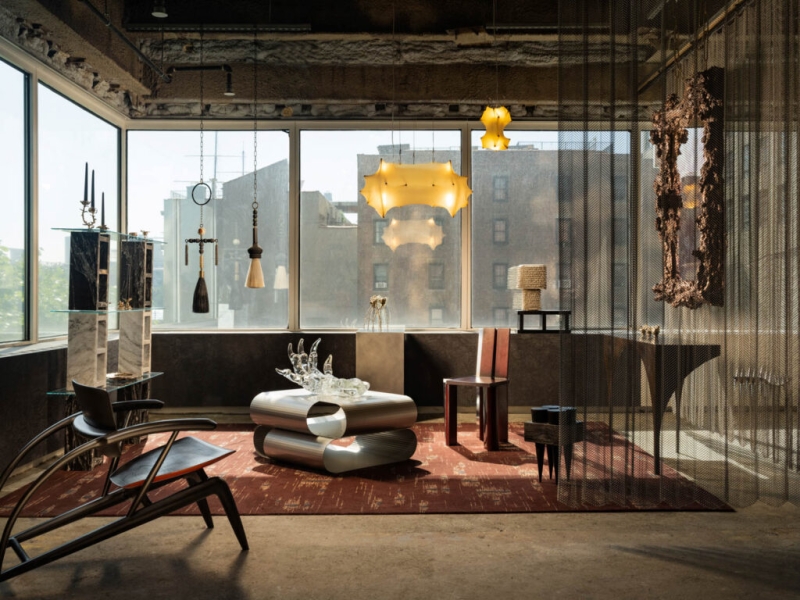Contents
Studio S II’s display presents a sharp vignette of earthy-toned furniture pieces and objects from 13 different artisans. Photography courtesy of Studio S II.
After seven editions in its hometown Brussels, COLLECTIBLE recently wrapped in New York, adding to the mix of those in art, fashion, design, and tennis zigzagging around town. Filling the void of a fair solely committed to presenting contemporary design, the outing took over two floors at downtown Manhattan’s Water Street Associates (WSA) building. The 31-floor Fox & Fowle-designed high-rise, which once housed suit-clad financiers, granted its 1980s outfit to the most current in collectible design, from furniture to objects, art, and even speakers. COLLECTIBLE founders Liv Vaisberg and Clélie Debehault partnered with designer Emily Marant to spearhead the fair’s New York edition, which opened during the ambitiously-packed first week of September. “The fair emphasizes designs that blur the line between function and art, creating a space where fresh ideas and experimental approaches take center stage,” Debehault told Interior Design.
“There’s a strong sense of curiosity and appreciation for the stories behind the works, which is exactly what we were hoping for,” added Vaisberg. “One pleasant surprise has been the level of dialogue sparked by the installations—many visitors are not just viewing but actively engaging in conversations with the galleries, designers, curators, and even among themselves about the ideas behind the work.” The fair founder has a point. The vernissage’s swarming audience was the first to experience the fair’s eight sections, which provided platform to individual designers and studios in sections such as New Garde, Architect ⇔ Designer, and Curated. Outdoor, on the other hand, focused on objects created for outdoor use while the brand section Fashion underlined the growing collaborative soul between fashion and industrial designers.
Explore The Must-See Highlights From COLLECTIBLE New York
Fefo Studio
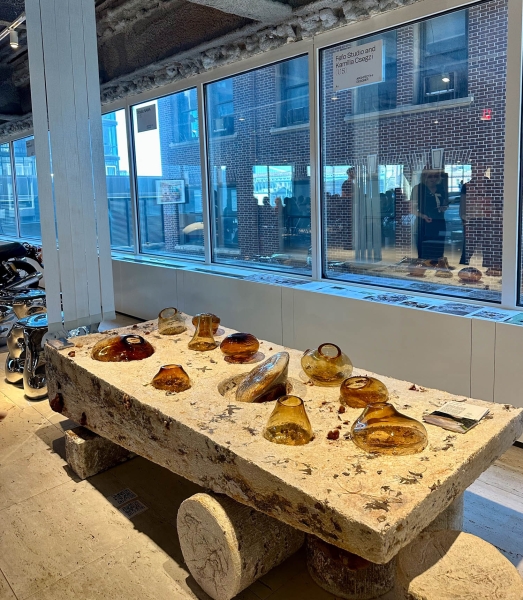
Ephemeral Table by Fefo Studio. Photography by Osman Can Yerebakan.
Argentinian designer Fernando Aciar’s presentation with his Brooklyn-based practice Ostudio, Fefo Studio, is among the crowd-pleasers. The invitingly-tactile central piece is the large Ephemeral Table which Aciar created out of various kinds of scraps over a year, including dried leaves and ceramic bits from his studio. Also a chef, the designer collaborated with architect Kamilla Csezgi to stiffen their pickings with mycelium.
“We have enough things out there—we don’t need more materials,” Aciar told Interior Design. Throughout the process, they used plates, bowls, and even tables around the studio to shape the feasting table. The final work on view includes a suite of yellow glass vessels that each fits perfectly into the furniture piece’s surface, owing it to the molding process. A perfect greeter of fall, the display with yellow and brown hues underscores the circularity in nature, as well as the human urge to create out of this rhythm.
Otras Formas
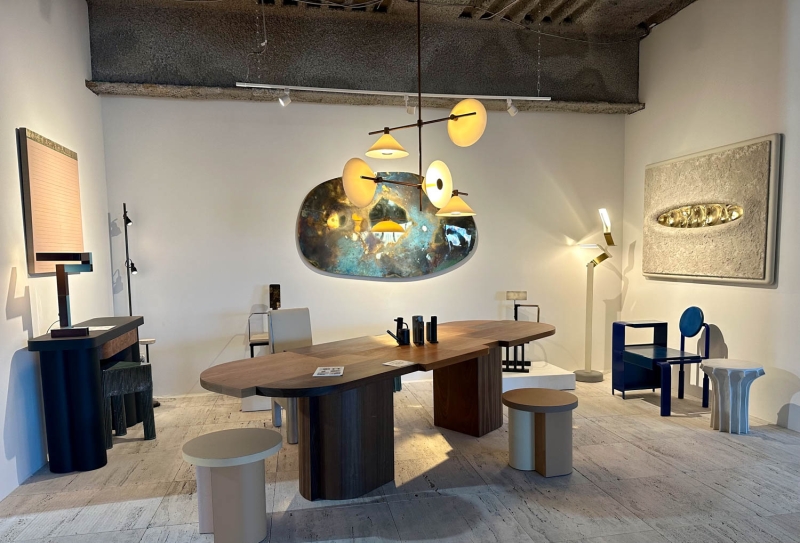
This display features Malcolm Majer’s Sorrell Telephone Chair, made of steel, tinted maple, glass and linoleum, as well as Teruko Kushi’s scene-stealing Cloud Mirror. Photography by Osman Can Yerebakan.
Chelsea gallery Otras Formas brings together a medley of their designers, orchestrating a suggestion of a living room. A standout is a version of Malcolm Majer’s sleek sculptural chair in dark blue. Titled Sorrell Telephone Chair, the steel, tinted maple, glass, and linoleum seat is both light and bulbous, cartoonish yet serious with a minimalist silhouette that achieves flamboyance. Teruko Kushi’s Cloud Mirror is a scene-stealer as well. The large scale ovoid creation is polished and painted, with a bronze finish. Blending the function of reflection with a painterly surface, the mirror is positioned between the contemporary and the aged.
Silence Please
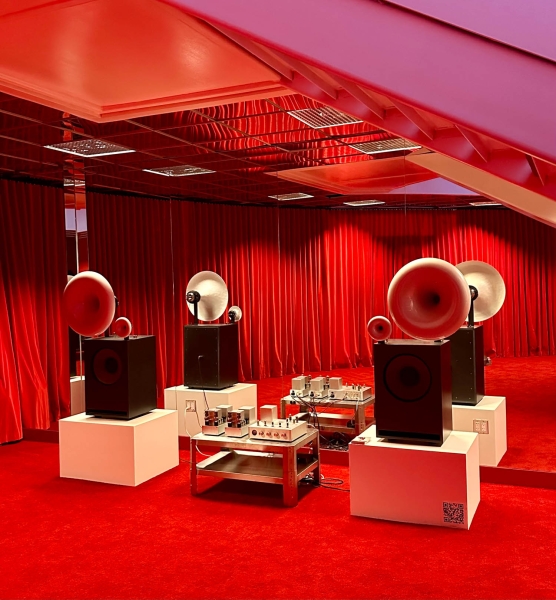
Silence Please’s all-red display at COLLECTIBLE. Photography by Osman Can Yerebakan.
The fair’s welcoming installation benefits from the building’s past as a mega office hub with hints of 1980s excess. Perched beneath a massive curvaceous staircase, the installation of two speakers by the brand new design studio Silence Please booms dance beats for the arriving guests. The circular speakers with glossy white horns are enveloped by a bold red carpeting and same color curtains which elevates their nocturnal hint. Upstairs, the studio exhibits a line of smaller speakers in front of the Manhattan skyline in unexpected materials, such as plexiglass.
Studio S II
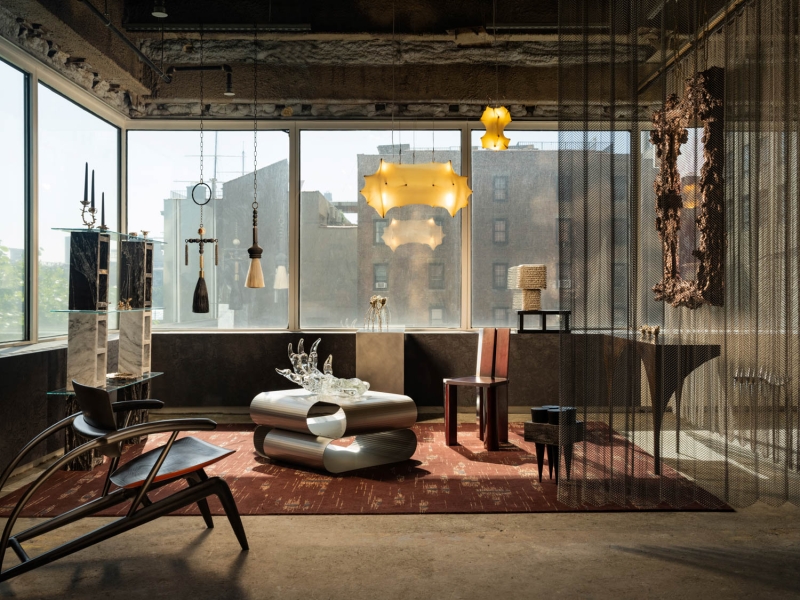
Studio S II’s display presents a sharp vignette of earthy-toned furniture pieces and objects from 13 different artisans. Photography courtesy of Studio S II.
Brooklyn-based studio Studio S II has recently come out of a collaboration between Erica Sellers and Jeremy Silberberg, and before the duo launches a brick and mortar gallery in Ridgewood, New Jersey, next year, they are testing the waters with a booth that features 13 designers and practices, including Mark Malecki, Rae Godin, and Two Tree Studios. Tucked in a corner, the show presents a sharp vignette of earthy-toned furniture pieces and objects with immediate textures and mysterious attractions.
Take, for example, J McDonald’s Creature Table, a steel creation with skinny legs that grow into an ethereal but sturdy surface in addition to a painterly patina. Nima Jeizan, a Tehran-born New York-based designer, blends traditional craft of his home country with a contemporary edge and sometimes performative potentials. Jeizan’s suspended mixed-media sculpture is hung by the window with the backdrop of Wall Street high-rises. Between the metal’s coldness to a fuzzy tassel, the arrangement holds a both spiritual and celebratory presence.
Sight Unseen x Petra Hardware
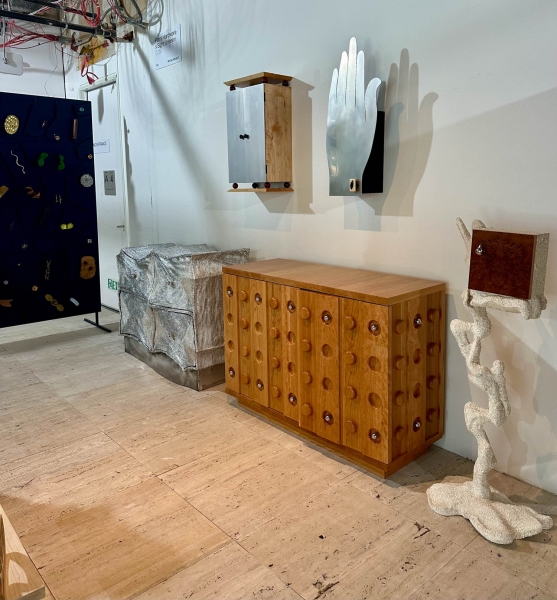
Collaboration between Sight Unseen x Petra Hardware. Photography by Osman Can Yerebakan.
The collaborative presentation between Sight Unseen and Petra Hardware, which was established by the editorial platform’s co-founder Monica Khemsurov offers yet another juxtaposition with domestic inspirations. Humor is a running thread amongst the objects and furniture pieces, which heavily lean on wood and steel.
Studio POA’s vertical cabinet Hachi Roku defies pine’s firm nature with its oozing form, while its green shade and soft texture add a whimsical energy to the material. Jesse Groom’s Cicatrix is another cabinet with a similarly unconventional silhouette. Vertically formed, the aluminum piece has a retro-futuristic radiance with its metallic wavy surface, creating a charming visual contrast with Muhly Studio’s adjacent cherry console in which a minimalist body meets circular accents.
Of The Cloth
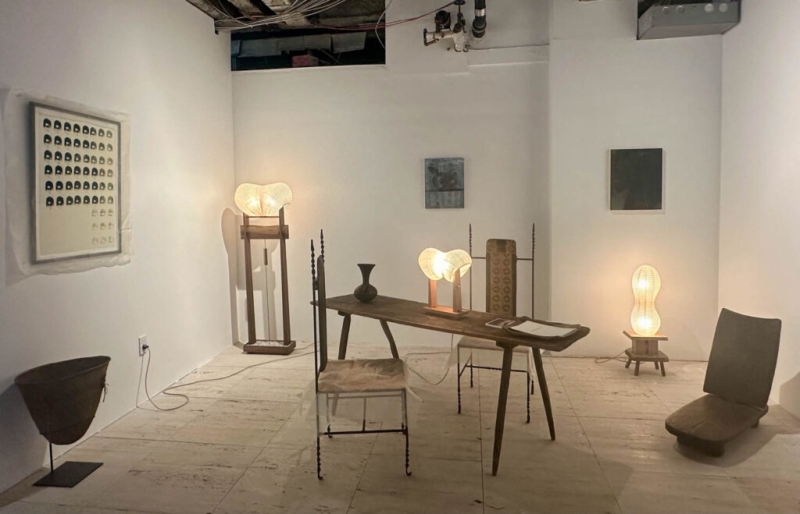
Of The Cloth presents A Dream Affirmed, which features a very mindful and demure suite of furniture pieces and artwork. Photography by Osman Can Yerebakan.
Another Brooklyn-born design practice, Of The Cloth, lays out an inviting yet demure suite of furniture pieces and artworks as a concept titled A Dream Affirmed. Kawabi, a studio founded by Irisa Na and Aaron Kawabi, exhibits table top and standalone lamps in intriguing materials such as rattan, kozo paper, and granite chips, as well as walnut and brass.
Their bulbous shades and clean-cut legs are in conversation with Kevin Claiborne’s moody paintings which sheds a contemplative light on the Black experience. A bold shade of blue repeats in two wood panel paintings while a silkscreen print repeats the portrait of a Black boy. The traits from Claiborne’s practice in murals, photography, and archive are evident in the presentation which also accompanies chairs by Kim Hill.
The Vernacular Modern
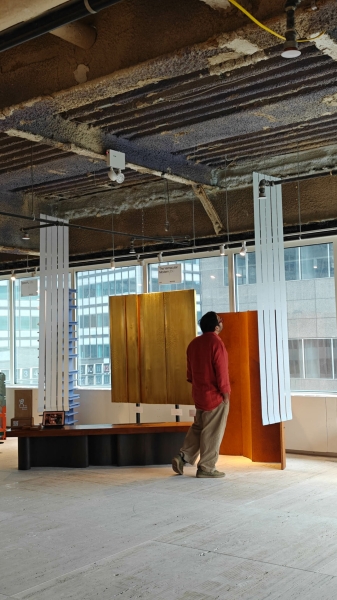
The Vernacular Modern has an all-wooden display. Photography by Of The Cloth presents A Dream Affirmed, which features a very mindful and demure suite of furniture pieces and artwork. Photography courtesy of The Vernacular Modern.
The Bangalore-based design practice The Vernacular Modern celebrates wood with a small but absorbing presentation. A long bench, a divider, and an artwork create a trifecta of craftsmanship which particularly resonates with the practice co-founded by Abhirup Dutta who previously ran the wood workshop Woodlabs. Our relationship with earth is both the inspiration and the source material for the trio, such as the Ghariyal Pittikai bench combines teak with an inlaying technique for the titular alligator motif whose fiery eyes are made out of sea shells. The Mati Deewar partition is reticent to reveal its material—soil—easily tricking the eye by resembling leather or brass. The panel salutes ancient Indian tradition of building walls from earth, while bringing an actual piece of India to downtown Manhattan.
St Vincents and Michael Hilal
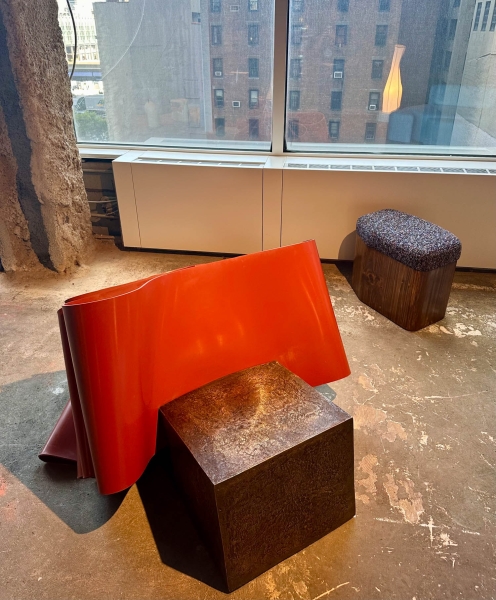
St Vincents and Michael Hilal’s collaboration for COLLECTIBLE. Photography by Osman Can Yerebakan.
Design gallery St Vincents from Antwerp collaborates with San Francisco-based interior designer Michael Hilal for an installation of furniture pieces by the likes of Samantha McCurdy, Ian Felton, Nick Valentijn, and Studio Kuhlmann. A standout is Brian Thoreen’s Rational/Irrational Elephant Chair in which a cast bronze seat with a long scrap of red neoprene rubber back rolls into an elephant trunk-like extension.
“They are two materials that should not work on paper but they do,” says the gallery co-founder, Geraldine Jackman. The contrast between two materials’ tactile and utilitarian qualities yields an unexpected visual, as well as a sculptural form. Thoreen’s references include material-forward Minimalist artists such as Robert Morris and Richard Serra, while he also suggests a tongue-in-cheek take on subjectivity in design through the rubber slab’s adaptability to any interior.
